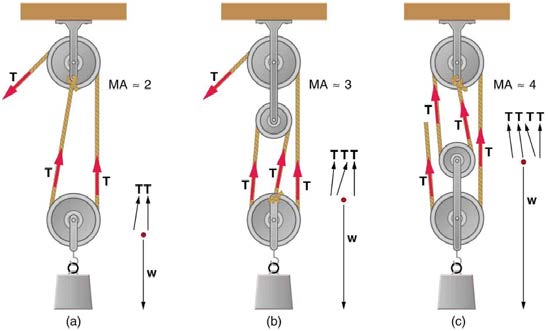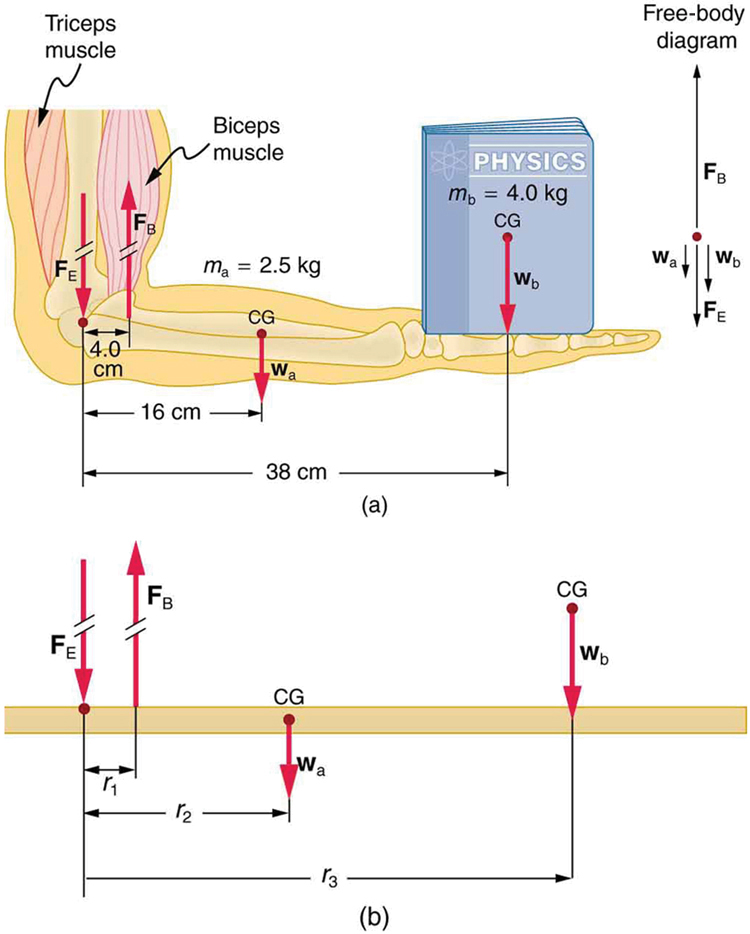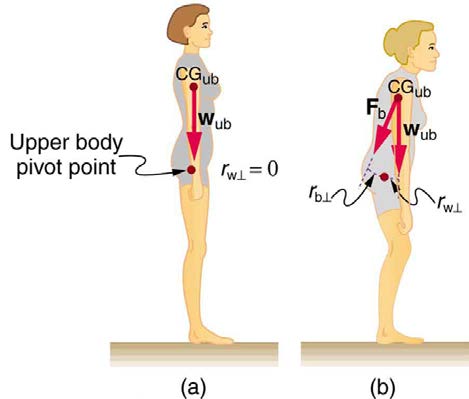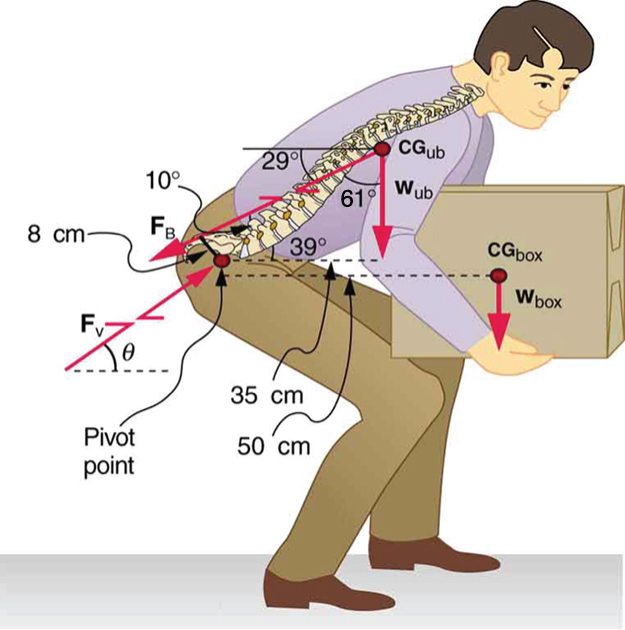Figure 9.25 (a) A crank is a type of lever that can be rotated 360º about its pivot. Cranks are usually designed to have a large MA. (b) A simplified automobile axle drives a
wheel, which has a much larger diameter than the axle. The MA is less than 1. (c) An ordinary pulley is used to lift a heavy load. The pulley changes the direction of the force
T exerted by the cord without changing its magnitude. Hence, this machine has an MA of 1.
An ordinary pulley has an MA of 1; it only changes the direction of the force and not its magnitude. Combinations of pulleys, such as those illustrated
in Figure 9.26, are used to multiply force. If the pulleys are friction-free, then the force output is approximately an integral multiple of the tension in the cable. The number of cables pulling directly upward on the system of interest, as illustrated in the figures given below, is approximately the MA of
the pulley system. Since each attachment applies an external force in approximately the same direction as the others, they add, producing a total
force that is nearly an integral multiple of the input force T .

304 CHAPTER 9 | STATICS AND TORQUE
Figure 9.26 (a) The combination of pulleys is used to multiply force. The force is an integral multiple of tension if the pulleys are frictionless. This pulley system has two cables attached to its load, thus applying a force of approximately 2 T . This machine has MA ≈ 2 . (b) Three pulleys are used to lift a load in such a way that the mechanical advantage is about 3. Effectively, there are three cables attached to the load. (c) This pulley system applies a force of 4 T , so that it has MA ≈ 4 . Effectively, four cables are pulling on the system of interest.
9.6 Forces and Torques in Muscles and Joints
Muscles, bones, and joints are some of the most interesting applications of statics. There are some surprises. Muscles, for example, exert far greater
forces than we might think. Figure 9.27 shows a forearm holding a book and a schematic diagram of an analogous lever system. The schematic is a
good approximation for the forearm, which looks more complicated than it is, and we can get some insight into the way typical muscle systems
function by analyzing it.
Muscles can only contract, so they occur in pairs. In the arm, the biceps muscle is a flexor—that is, it closes the limb. The triceps muscle is an
extensor that opens the limb. This configuration is typical of skeletal muscles, bones, and joints in humans and other vertebrates. Most skeletal
muscles exert much larger forces within the body than the limbs apply to the outside world. The reason is clear once we realize that most muscles
are attached to bones via tendons close to joints, causing these systems to have mechanical advantages much less than one. Viewing them as
simple machines, the input force is much greater than the output force, as seen in Figure 9.27.

CHAPTER 9 | STATICS AND TORQUE 305
Figure 9.27 (a) The figure shows the forearm of a person holding a book. The biceps exert a force FB to support the weight of the forearm and the book. The triceps are
assumed to be relaxed. (b) Here, you can view an approximately equivalent mechanical system with the pivot at the elbow joint as seen in Example 9.4.
Example 9.4 Muscles Exert Bigger Forces Than You Might Think
Calculate the force the biceps muscle must exert to hold the forearm and its load as shown in Figure 9.27, and compare this force with the
weight of the forearm plus its load. You may take the data in the figure to be accurate to three significant figures.
Strategy
There are four forces acting on the forearm and its load (the system of interest). The magnitude of the force of the biceps is F B ; that of the
elbow joint is F E ; that of the weights of the forearm is w a , and its load is w b . Two of these are unknown ( F B and F E ), so that the first condition for equilibrium cannot by itself yield F B . But if we use the second condition and choose the pivot to be at the elbow, then the torque
due to F E is zero, and the only unknown becomes F B .
Solution
The torques created by the weights are clockwise relative to the pivot, while the torque created by the biceps is counterclockwise; thus, the
second condition for equilibrium (net τ = 0) becomes
r
(9.35)
2 w a + r 3 w b = r 1 F B.
Note that sin θ = 1 for all forces, since θ = 90º for all forces. This equation can easily be solved for F B in terms of known quantities,
yielding
(9.36)
F B = r 2 w a + r 3 w b
r
.
1
Entering the known values gives
⎛
⎛
(9.37)
(0.160 m)⎛
F
⎝2.50 kg⎞⎠⎝9.80 m/s2⎞⎠ + (0.380 m)⎛⎝4.00 kg⎞⎠⎝9.80 m/s2⎞⎠
B =
0.0400 m
306 CHAPTER 9 | STATICS AND TORQUE
which yields
F
(9.38)
B = 470 N.
Now, the combined weight of the arm and its load is ⎛
⎛
⎝6.50 kg⎞⎠⎝9.80 m/s2⎞⎠ = 63.7 N , so that the ratio of the force exerted by the biceps to the
total weight is
F
(9.39)
B
w
= 470
a + w b
63.7 = 7.38.
Discussion
This means that the biceps muscle is exerting a force 7.38 times the weight supported.
In the above example of the biceps muscle, the angle between the forearm and upper arm is 90°. If this angle changes, the force exerted by the
biceps muscle also changes. In addition, the length of the biceps muscle changes. The force the biceps muscle can exert depends upon its length; it
is smaller when it is shorter than when it is stretched.
Very large forces are also created in the joints. In the previous example, the downward force F E exerted by the humerus at the elbow joint equals
407 N, or 6.38 times the total weight supported. (The calculation of F E is straightforward and is left as an end-of-chapter problem.) Because
muscles can contract, but not expand beyond their resting length, joints and muscles often exert forces that act in opposite directions and thus
subtract. (In the above example, the upward force of the muscle minus the downward force of the joint equals the weight supported—that is,
470 N – 407 N = 63 N , approximately equal to the weight supported.) Forces in muscles and joints are largest when their load is a long distance
from the joint, as the book is in the previous example.
In racquet sports such as tennis the constant extension of the arm during game play creates large forces in this way. The mass times the lever arm of
a tennis racquet is an important factor, and many players use the heaviest racquet they can handle. It is no wonder that joint deterioration and
damage to the tendons in the elbow, such as “tennis elbow,” can result from repetitive motion, undue torques, and possibly poor racquet selection in
such sports. Various tried techniques for holding and using a racquet or bat or stick not only increases sporting prowess but can minimize fatigue and
long-term damage to the body. For example, tennis balls correctly hit at the “sweet spot” on the racquet will result in little vibration or impact force
being felt in the racquet and the body—less torque as explained in Collisions of Extended Bodies in Two Dimensions. Twisting the hand to
provide top spin on the ball or using an extended rigid elbow in a backhand stroke can also aggravate the tendons in the elbow.
Training coaches and physical therapists use the knowledge of relationships between forces and torques in the treatment of muscles and joints. In
physical therapy, an exercise routine can apply a particular force and torque which can, over a period of time, revive muscles and joints. Some
exercises are designed to be carried out under water, because this requires greater forces to be exerted, further strengthening muscles. However,
connecting tissues in the limbs, such as tendons and cartilage as well as joints are sometimes damaged by the large forces they carry. Often, this is
due to accidents, but heavily muscled athletes, such as weightlifters, can tear muscles and connecting tissue through effort alone.
The back is considerably more complicated than the arm or leg, with various muscles and joints between vertebrae, all having mechanical
advantages less than 1. Back muscles must, therefore, exert very large forces, which are borne by the spinal column. Discs crushed by mere exertion
are very common. The jaw is somewhat exceptional—the masseter muscles that close the jaw have a mechanical advantage greater than 1 for the
back teeth, allowing us to exert very large forces with them. A cause of stress headaches is persistent clenching of teeth where the sustained large
force translates into fatigue in muscles around the skull.
Figure 9.28 shows how bad posture causes back strain. In part (a), we see a person with good posture. Note that her upper body’s cg is directly
above the pivot point in the hips, which in turn is directly above the base of support at her feet. Because of this, her upper body’s weight exerts no
torque about the hips. The only force needed is a vertical force at the hips equal to the weight supported. No muscle action is required, since the
bones are rigid and transmit this force from the floor. This is a position of unstable equilibrium, but only small forces are needed to bring the upper
body back to vertical if it is slightly displaced. Bad posture is shown in part (b); we see that the upper body’s cg is in front of the pivot in the hips. This
creates a clockwise torque around the hips that is counteracted by muscles in the lower back. These muscles must exert large forces, since they
have typically small mechanical advantages. (In other words, the perpendicular lever arm for the muscles is much smaller than for the cg.) Poor
posture can also cause muscle strain for people sitting at their desks using computers. Special chairs are available that allow the body’s CG to be
more easily situated above the seat, to reduce back pain. Prolonged muscle action produces muscle strain. Note that the cg of the entire body is still
directly above the base of support in part (b) of Figure 9.28. This is compulsory; otherwise the person would not be in equilibrium. We lean forward for the same reason when carrying a load on our backs, to the side when carrying a load in one arm, and backward when carrying a load in front of
us, as seen in Figure 9.29.


CHAPTER 9 | STATICS AND TORQUE 307
Figure 9.28 (a) Good posture places the upper body’s cg over the pivots in the hips, eliminating the need for muscle action to balance the body. (b) Poor posture requires
exertion by the back muscles to counteract the clockwise torque produced around the pivot by the upper body’s weight. The back muscles have a small effective perpendicular
lever arm, r b ⊥ , and must therefore exert a large force Fb . Note that the legs lean backward to keep the cg of the entire body above the base of support in the feet.
You have probably been warned against lifting objects with your back. This action, even more than bad posture, can cause muscle strain and
damage discs and vertebrae, since abnormally large forces are created in the back muscles and spine.
Figure 9.29 People adjust their stance to maintain balance. (a) A father carrying his son piggyback leans forward to position their overall cg above the base of support at his
feet. (b) A student carrying a shoulder bag leans to the side to keep the overall cg over his feet. (c) Another student carrying a load of books in her arms leans backward for the
same reason.
Example 9.5 Do Not Lift with Your Back
Consider the person lifting a heavy box with his back, shown in Figure 9.30. (a) Calculate the magnitude of the force F B – in the back muscles that is needed to support the upper body plus the box and compare this with his weight. The mass of the upper body is 55.0 kg and the mass of
the box is 30.0 kg. (b) Calculate the magnitude and direction of the force FV – exerted by the vertebrae on the spine at the indicated pivot
point. Again, data in the figure may be taken to be accurate to three significant figures.
Strategy
By now, we sense that the second condition for equilibrium is a good place to start, and inspection of the known values confirms that it can be
used to solve for F B – if the pivot is chosen to be at the hips. The torques created by wub and wbox – are clockwise, while that created by
FB – is counterclockwise.
Solution for (a)
Using the perpendicular lever arms given in the figure, the second condition for equilibrium (net τ = 0) becomes
⎛
⎛
(9.40)
(0.350 m)⎛⎝55.0 kg⎞⎠⎝9.80 m/s2⎞⎠ + (0.500 m)⎛⎝30.0 kg⎞⎠⎝9.80 m/s2⎞⎠ = (0.0800 m) F B.
Solving for F B yields
(9.41)
F B = 4.20×103 N.
The ratio of the force the back muscles exert to the weight of the upper body plus its load is
308 CHAPTER 9 | STATICS AND TORQUE
F
(9.42)
B
w
= 4200 N
ub + w box
833 N = 5.04.
This force is considerably larger than it would be if the load were not present.
Solution for (b)
More important in terms of its damage potential is the force on the vertebrae FV . The first condition for equilibrium ( net F = 0 ) can be used to
find its magnitude and direction. Using y for vertical and x for horizontal, the condition for the net external forces along those axes to be zero
(9.43)
net Fy = 0 and net Fx = 0.
Starting with the vertical ( y ) components, this yields
F
(9.44)
V y – w ub – w box – F B sin 29.0º = 0.
Thus,
F
(9.45)
V y = w ub + w box + F B sin 29.0º
= 833 N + (4200 N) sin 29.0º
yielding
(9.46)
F V y = 2.87×103 N.
Similarly, for the horizontal ( x ) components,
F
(9.47)
V x – F B cos 29.0º = 0
yielding
(9.48)
F V x = 3.67×103 N.
The magnitude of FV is given by the Pythagorean theorem:
(9.49)
F
2
2
V = F V x + F V y = 4.66×103 N.
The direction of FV is
F
(9.50)
⎞
θ = tan – 1⎛ V y
⎝ F V x⎠ = 38.0º.
Note that the ratio of F V to the weight supported is
F
(9.51)
V
w
= 4660 N
ub + w box
833 N = 5.59.
Discussion
This force is about 5.6 times greater than it would be if the person were standing erect. The trouble with the back is not so much that the forces
are large—because similar forces are created in our hips, knees, and ankles—but that our spines are relatively weak. Proper lifting, performed
with the back erect and using the legs to raise the body and load, creates much smaller forces in the back—in this case, about 5.6 times smaller.

CHAPTER 9 | STATICS AND TORQUE 309
Figure 9.30 This figure shows that large forces are exerted by the back muscles and experienced in the vertebrae when a person lifts with their back, since these muscles
have small effective perpendicular lever arms. The data shown here are analyzed in the preceding example, Example 9.5.
What are the benefits of having most skeletal muscles attached so close to joints? One advantage is speed because small muscle contractions can
produce large movements of limbs in a short period of time. Other advantages are flexibility and agility, made possible by the large numbers of joints
and the ranges over which they function. For example, it is difficult to imagine a system with biceps muscles attached at the wrist that would be
capable of the broad range of movement we vertebrates possess.
There are some interesting complexities in real systems of muscles, bones, and joints. For instance, the pivot point in many joints changes location
as the joint is flexed, so that the perpendicular lever arms and the mechanical advantage of the system change, too. Thus the force the biceps
muscle must exert to hold up a book varies as the forearm is flexed. Similar mechanisms operate in the legs, which explain, for example, why there is
less leg strain when a bicycle seat is set at the proper height. The methods employed in this section give a reasonable description of real systems
provided enough is known about the dimensions of the system. There are many other interesting examples of force and torque in the body—a few of
these are the subject of end-of-chapter problems.
Glossary
center of gravity: the point where the total weight of the body is assumed to be concentrated
dynamic equilibrium: a state of equilibrium in which the net external force and torque on a system moving with constant velocity are zero
mechanical advantage: the ratio of output to input forces for any simple machine
neutral equilibrium: a state of equilibrium that is independent of a system’s displacements from its original position
perpendicular lever arm: the shortest distance from the pivot point to the line along which F lies
SI units of torque: newton times meters, usually written as N·m
stable equilibrium: a system, when displaced, experiences a net force or torque in a direction opposite to the direction of the displacement
static equilibrium: a state of equilibrium in which the net external force and torque acting on a system is zero
static equilibrium: equilibrium in which the acceleration of the system is zero and accelerated rotation does not occur
torque: turning or twisting effectiveness of a force
unstable equilibrium: a system, when displaced, experiences a net force or torque in the same direction as the displacement from equilibrium
Section Summary
9.1 The First Condition for Equilibrium
• Statics is the study of forces in equilibrium.
• Two conditions must be met to achieve equilibrium, which is defined to be motion without linear or rotational acceleration.
• The first condition necessary to achieve equilibrium is that the net external force on the system must be zero, so that net F = 0 .
9.2 The Second Condition for Equilibrium
• The second condition assures those torques are also balanced. Torque is the rotational equivalent of a force in producing a rotation and is
defined to be
τ = rF sin θ
310 CHAPTER 9 | STATICS AND TORQUE
where τ is torque, r is the distance from the pivot point to the point where the force is applied, F is the magnitude of the force, and θ is the
angle between F and the vector directed from the point where the force acts to the pivot point. The perpendicular lever arm r⊥ is defined to
be
r⊥ = r sin θ
so that
τ = r⊥ F.
• The perpendicular lever arm r⊥ is the shortest distance from the pivot point to the line along which F acts. The SI unit for torque is newton-
meter (N·m) . The second condition necessary to achieve equilibrium is that the net external torque on a system must be zero:
net τ = 0
By convention, clockwise torques are positive, and counterclockwise torques are negative.
9.3 Stability
• A system is said to be in stable equilibrium if, when displaced from equilibrium, it experiences a net force or torque in a direction opposite the
direction of the displacement.
• A system is in unstable equilibrium if, when displaced from equilibrium, it experiences a net force or torque in the same direction as the
displacement from equilibrium.
• A system is in neutral equilibrium if its equilibrium is independent of displacements from its original position.
9.4 Applications of Statics, Including Problem-Solving Strategies
• Statics can be applied to a variety of situations, ranging from raising a drawbridge to bad posture and back strain. We have discussed the
problem-solving strategies specifically useful for statics. Statics is a special case of Newton’s laws, both the general problem-solving strategies
and the special strategies for Newton’s laws, discussed in Problem-Solving Strategies, still apply.
9.5 Simple Machines
• Simple machines are devices that can be used to multiply or augment a force that we apply – often at the expense of a distance through which
we have to apply the force.
• The ratio of output to input forces for any simple machine is called its mechanical advantage
• A few simple machines are the lever, nail puller, wheelbarrow, crank, etc.
9.6 Forces and Torques in Muscles and Joints
• Statics plays an important part in understanding everyday strains in our muscles and bones.
• Many lever systems in the body have a mechanical advantage of significantly less than one, as many of our muscles are attached close to
joints.
• Someone with good posture stands or sits in such as way that their center of gravity lies directly above the pivot point in their hips, thereby
avoiding back strain and damage to disks.
Conceptual Questions
9.1 The First Condition for Equilibrium
1. What can you say about the velocity of a moving body that is in dynamic equilibrium? Draw a sketch of such a body using clearly labeled arrows to
represent all external forces on the body.
2. Under what conditions can a rotating body be in equilibrium? Give an example.
9.2 The Second Condition for Equilibrium
3. What three factors affect the torque created by a force relative to a specific pivot point?
4. A wrecking ball is being used to knock down a building. One tall unsupported concrete wall remains standing. If the wrecking ball hits the wall near
the top, is th








